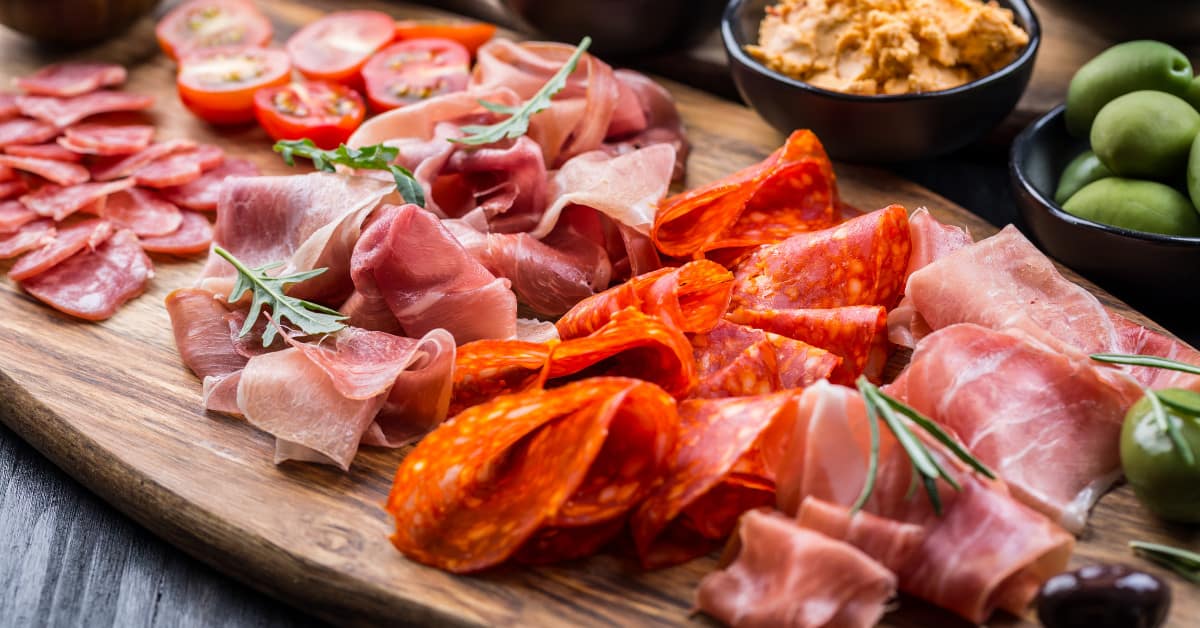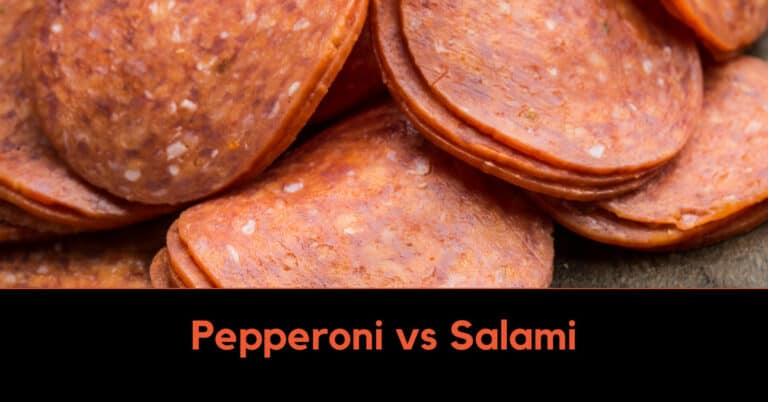**SUMMARY:** This article explores the key differences between pepperoni and salami. Pepperoni is a spicier, American-style sausage typically made from pork and beef. At the same time, salami is a more diverse type of cured sausage from Italy, often characterized by its tangy flavors and a wide variety of ingredients.
Pepperoni vs Salami: Which Cured Meat Reigns Supreme?
Are you torn between the sizzling spiciness of pepperoni and the rich tanginess of salami?
This article will explore the key differences between pepperoni and salami, their distinct flavor profiles, culinary uses, and popularity, allowing you to decide when to add these delectable cured meats to your meals.
In this article, we will cover:
- The flavor profiles of pepperoni and salami
- The culinary uses of both ingredients
- The popularity and availability of each
- Personal preferences and recommendations for choosing between the two
Flavor Profile
When it comes to flavor, pepperoni and salami offer distinct taste experiences that can elevate your dishes in unique ways. Let’s dive into the flavor profiles of each:
Pepperoni
- Spicy Kick: Known for its signature spiciness, pepperoni packs a punch that adds a touch of heat to any dish.
- Savory Notes: Combining herbs and spices, such as paprika, garlic, and black pepper, gives pepperoni a savory and bold flavor.
- Smoky Undertones: Slow curing or smoking processes lend a smoky essence to pepperoni, enhancing its overall taste.
Salami
- Richness and Depth: Salami boasts a rich and indulgent flavor with hints of garlic, fennel, or other seasonings, depending on the specific variety.
- Tanginess: The fermentation process in salami production creates a delightful tanginess that balances the richness, making each bite vibrant and satisfying.
Whether you gravitate towards the fiery spiciness of pepperoni or prefer the robust richness of salami, incorporating these cured meats can bring a burst of flavor that will tantalize your taste buds.
Culinary Uses:
Pepperoni and salami are beloved cured meats that bring distinct flavors and textures to various dishes. While they may appear similar at first glance, their unique characteristics make them well-suited for different culinary applications. Let’s explore how these two ingredients are used in cooking:

Pepperoni
- One of the most popular uses of pepperoni is on pizzas. Its intense, slightly spicy flavor infuses the entire pie, adding a delicious kick to each bite.
- Pepperoni also shines in sandwiches, with its robust flavor against other ingredients. It adds a zesty punch, whether layered in a sub or sliced onto a burger.
- In pasta dishes, add pepperoni to sauces, providing depth and richness. The saltiness and smokiness of pepperoni can elevate the overall flavor profile of classic pasta recipes.
- For those seeking a snack or appetizer, pepperoni slices are often found in antipasto platters. They pair well with various cheeses, olives, and pickled vegetables, creating a harmonious combination of flavors.

Salami
- Salami’s versatility also shines in antipasti platters, where it is often the show’s star. With its rich and slightly tangy taste, sliced salami pairs perfectly with other cured meats, cheeses, and accompaniments.
- When it comes to sandwiches, salami brings a distinct flavor profile that adds depth and complexity. Its rich and savory notes, often enhanced by garlic or fennel seasoning, create a satisfying combination with bread and other fillings.
- Salami’s tanginess makes it a great addition to salads, providing a burst of flavor amidst fresh greens and other ingredients. It can be sliced into bite-sized pieces or added in thin strips, adding a punch of taste to every forkful.
- In various European cuisines, salami is often used in traditional dishes like pasta sauces, stews, and soups. Its umami-rich flavor enhances the overall taste and adds an exciting twist.
Whether you’re craving a pizza loaded with pepperoni or a charcuterie board adorned with salami, both these cured meats bring their unique flavors to the table. Keep exploring and experimenting with these ingredients to discover the endless possibilities they offer in the culinary world.
Popularity and Availability
Pepperoni and salami have gained popularity worldwide, each with their unique cultural associations and culinary traditions. Let’s delve into the popularity and availability of these flavorful cured meats:
Popularity of Pepperoni
- Pepperoni has become synonymous with classic American pizza, making it one of the most beloved pizza toppings across the country.
- Its distinctive flavor and ability to retain its shape when cooked have contributed to its widespread popularity in the pizza industry.
- In addition to pizzas, pepperoni is commonly enjoyed as a topping for sandwiches, calzones, and even hot dogs in certain regions.
- Pepperoni’s availability is widespread, making it readily accessible in grocery stores, pizzerias, fast food chains, and restaurants globally.
Popularity of Salami
- Salami has a long-standing history in Italian cuisine, where it is commonly enjoyed as part of antipasti platters or in sandwiches such as the classic Italian sub.
- It has gained popularity in other Mediterranean cuisines as well, such as Spanish and Greek, due to its versatility and rich flavors.
- In recent years, salami has been embraced by food enthusiasts and chefs beyond its traditional Mediterranean roots, leading to its increased presence in diverse cuisines.
- The growing interest in charcuterie and artisanal cured meats has further boosted the popularity of salami in various regions around the world.
Availability of Pepperoni and Salami
- Pepperoni, being a staple in American cuisine, is widely available in grocery stores, pizzerias, and restaurants throughout the United States and many other countries.
- It can be found both in pre-packaged slices, as well as at deli counters.
- Salami, with its strong Italian and Mediterranean influence, can be found in a multitude of variations and flavors.
- It is commonly available in specialty delis, gourmet food stores, and international markets that cater to a diverse range of culinary preferences.
- Both pepperoni and salami are relatively easy to find in the deli meats section of most well-stocked grocery stores worldwide.

Whether you prefer the classic appeal of pepperoni on your pizza or the diverse flavors of salami in your charcuterie platter, both these cured meats have established popularity and can be easily sourced in numerous locations. Embrace their flavors and explore the culinary possibilities they bring to your kitchen.
Personal Preference and Recommendations
When choosing between pepperoni and salami, personal preference plays a significant role. Each offers a distinct flavor profile, and the decision ultimately depends on individual taste preferences and recipe requirements. Here are some factors to consider when deciding between the two:
Flavor Preference
- If you enjoy bold, spicy flavors with a hint of smokiness, pepperoni is likely to be your go-to choice.
- Conversely, if you prefer a rich, tangy flavor with subtle garlic or fennel undertones, salami may be more to your liking.
- Consider the desired taste profile of your dish and how each ingredient will complement or enhance the flavors of other components.
Culinary Compatibility
- Reflect on the specific culinary application for which you’re selecting the cured meat.
- Pepperoni is a popular choice for pizzas, sandwiches, and pasta dishes, where its bold flavor can stand up to other ingredients.
- Salami, with its rich taste and tanginess, pairs well with antipasti platters, salads, and dishes where a milder cured meat is desired.
Recipe Requirements
- The recipe you’re preparing may have specific requirements that can dictate your choice between pepperoni and salami.
- Consider factors such as cooking method, compatibility with other ingredients, and even cultural or regional influences on the dish.
- Experimentation is encouraged to find the perfect balance of flavors for your recipe.
Variations to Explore
- While classic pepperoni and salami are readily available, there are numerous variations and regional varieties to discover.
- Explore artisanal or locally produced options that offer unique flavor profiles, such as spicy pepperoni or salami infused with herbs and spices.
- Additionally, consider exploring international variations of salami, such as Spanish chorizo or Hungarian kolbász, to add a global twist to your culinary creations.
Remember, both pepperoni and salami have their merits and can elevate the flavor of various dishes. Ultimately, it is a matter of personal taste and the specific requirements of your recipe. Don’t be afraid to experiment and discover new flavor combinations and variations that cater to your palate.

Key Takeaways: Pepperoni vs Salami
Exploring the flavors, culinary uses, popularity, and personal preferences of pepperoni and salami reveals their distinct characteristics and versatile nature. Here are the key takeaways:
- Pepperoni offers a spicy, savory, and smoky flavor, making it a staple in classic American pizzas and other dishes.
- Salami, however, boasts a rich, tangy flavor with garlic or fennel seasoning, making it a popular choice in Italian and Mediterranean cuisine.
- Both pepperoni and salami are delightful additions to sandwiches, salads, pasta dishes, and antipasti platters.
- The popularity of pepperoni stems from its association with traditional American pizza. At the same time, salami enjoys a growing fanbase in various regions.
- These ingredients are widely available in grocery stores and restaurants globally, allowing easy accessibility.
- Personal preference plays a crucial role in choosing between pepperoni and salami, as the flavors can cater to different tastes and recipe requirements.
- Exploring unique or lesser-known variations of pepperoni and salami can provide exciting culinary adventures for adventurous food enthusiasts.
In summary, understanding the distinguishing flavors, culinary uses, popularity, and personal preferences of pepperoni and salami allows individuals to make informed decisions when incorporating these ingredients into their meals. Whether enjoying pepperoni’s spiciness on a classic pizza or savoring the richness of salami on an antipasti platter, these flavorful ingredients continue to captivate food lovers worldwide.
Frequently Asked Questions
Are pepperoni and salami the same thing?
No, pepperoni and salami are not the same thing. While they both fall under the category of cured meat, they have distinct flavors and seasoning profiles.
Can I use pepperoni instead of salami in a recipe?
Yes, you can use pepperoni as a substitute for salami in most recipes. However, remember that the dish’s flavor and texture may vary slightly.
How long does pepperoni or salami last?
Both pepperoni and salami have a relatively long shelf life. Unopened packages can last for several weeks when stored properly, while opened packages should be consumed within a week.
Are there any vegetarian or vegan alternatives to pepperoni and salami?
Yes, there are vegetarian and vegan alternatives to pepperoni and salami. These alternatives are typically made from plant-based ingredients such as tofu, seitan, or mushrooms, offering similar flavors and textures.
Can I freeze pepperoni or salami?
Yes, you can freeze both pepperoni and salami. Freezing can extend their shelf life for several months. However, it is advisable to slice or portion them before freezing for ease of use.
What are some popular dishes that feature pepperoni and salami?
Pepperoni is commonly used in classic American pizzas, pasta dishes like baked ziti or pepperoni pasta bake, and as a topping in sandwiches like a turkey club. Salami is often found in Italian dishes such as pasta salads and antipasti platters and as a key component in sandwiches like the classic muffuletta.
Are pepperoni and salami gluten-free?
Generally, pepperoni and salami are gluten-free. However, checking the specific brand or manufacturer’s information is essential, as some varieties may include gluten-containing ingredients or potential cross-contamination.
Can I make my own pepperoni or salami at home?
Yes, it is possible to make homemade pepperoni or salami. However, it requires specialized equipment, knowledge of curing processes, and adherence to food safety guidelines. It is recommended to follow trusted recipes and procedures or consult an experienced charcuterie enthusiast before attempting to make them at home.
Do different regions have specific varieties of pepperoni and salami?
Yes, different regions around the world have their own unique varieties of pepperoni and salami. Each region adds its distinct spices, seasonings, and curing techniques, resulting in diverse flavors and textures.
How do I know if pepperoni or salami has gone bad?
Signs of spoiled pepperoni or salami include an off smell, slimy texture, mold growth, or a color change. If you notice any of these signs, it is best to discard the product to avoid any potential health risks.

